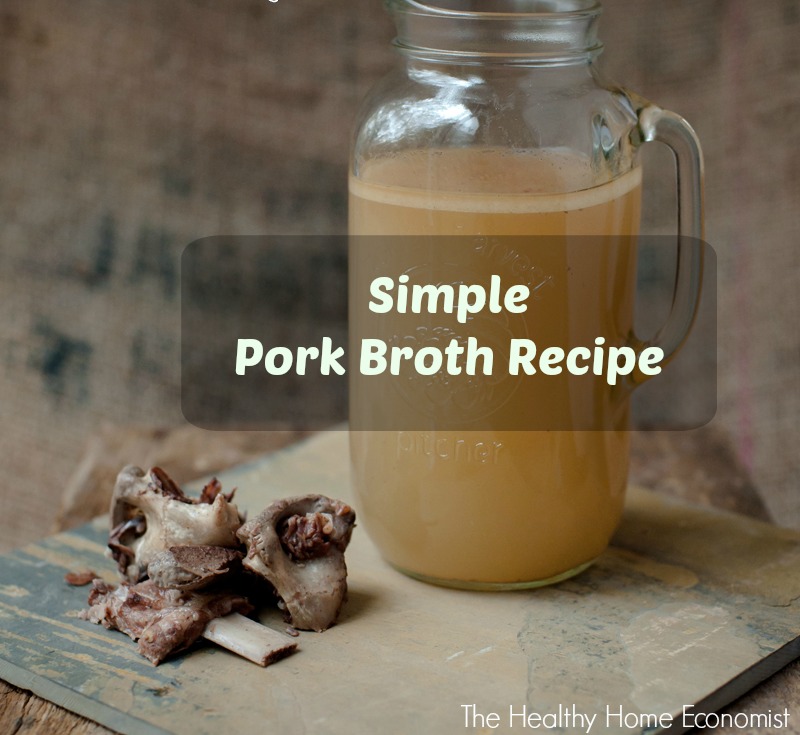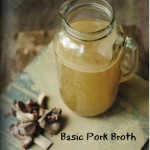 Making homemade bone broth is a crucial technique a Traditional Cook must master. Ideally, it is made at least once a week. Since quality bones are expensive, is pork broth an option? Most people have never considered it. Quality pastured pork at affordable prices is widely available in many communities. Let’s examine this question below.
Making homemade bone broth is a crucial technique a Traditional Cook must master. Ideally, it is made at least once a week. Since quality bones are expensive, is pork broth an option? Most people have never considered it. Quality pastured pork at affordable prices is widely available in many communities. Let’s examine this question below.
Health Requires Lots of Bone Broth – Why Not Pork?
I make a large pot of stock once or twice every week. Our family flies through quarts of it so quickly at mealtimes! A ready supply of gelatin and mineral rich broth in the freezer is also important when illness strikes. This nutrient rich food is a key player for rapid recovery without meds. This is especially true when a fever is involved.
Commercial Broth vs Homemade Broth
Getting sick and realizing there is no homemade bone broth is a devastating feeling, I can assure you! Simply running out to the store to pick up some canned soup or broth in a carton is not going to solve the problem. These industrially produced products even if organic are just water and MSG with little to no nutrient value and certainly no gelatin!
Even the properly made commercial bone broths available in recent years are not comparable to homemade. They are all watered down (every single brand I’ve tested). What’s worse, they are usually packaged in toxic plastic or plastic lined tetrapaks. The broth is boiling hot when it is poured into the containers if the product is shelf stable. Try it yourself. Put them in the refrigerator. They don’t gel like broth made at home does. The only brand worth buying is Epic bone broth in glass jars, but unfortunately it is still watered down.
Making your own broth has no substitute!
There is nothing worse than a tummy bug striking your children and knowing that a pot of gelatin rich stock that will halt the illness in its tracks is a full 24-48 hours away. Unless, of course, you can quickly source the right kind of fishheads, then a pot of stock can be ready in as little as 4 hours.
Pork Broth More Affordable than Most
With plenty of stock on hand for whatever your cooking or wellness needs might be, the next question is how to source quality bones at a price that is within a typical family’s food budget.
The highest quality pastured pork bones for making pork stock tend to cost between one half and three quarters as much as grassfed beef bones or pastured chicken in my experience, particularly if you source an entire hog.
Some might question how pork bones could make good pork broth given the fattiness of the meat. Culinary purists believe that soups and sauces made with fatty stock do not yield the best results. This problem is easily remedied by chilling pork stock in the refrigerator which allows the congealed pork fat to be removed from the top of the container of stock with a spoon.
If you’ve never tried pork broth or pork stock before, why don’t you give it a try? Here is a very simple and basic pork broth recipe to get you going. It is inspired by the beautiful book Beyond Bacon, Paleo Recipes that Respect the Whole Hog, by Stacy Toth and Matthew McCarry.
How to Make Pork Broth (Pork Stock)
The recipe for pork stock below makes about 2 quarts. Try it with your next batch! I’m sure you’re going to love it!


Pork Broth Recipe
How to make pork broth that is a affordable, nutritious, and delicious alternative to other more expensive stocks made with pastured poultry or grassfed beef bones.
Ingredients
- 3 lbs pastured pork bones
- 1 Tbl apple cider vinegar raw and unfiltered, preferably organic
- ground peppercorns
- sea salt
Instructions
-
Put all of the bones in a stockpot and add enough filtered water to cover.
Cook on high until the water comes to a boil and scum rises to the top. Cook for 5 minutes.
Dump the entire pot of water and refill with fresh filtered water, enough to cover the bones. Mix in the apple cider vinegar and bring the water to a boil once again.
Carefully skim off any foam that comes to the top. It should be minimal given that the water with most of the scum was dumped in the previous step.
Reduce heat and simmer on low for 9-24 hours.
Remove the pot from the heat, strain and taste. Add salt and pepper as needed. Let cool and then refrigerate in one or more airtight containers.
Skim the lard off the top of the chilled pork broth the following day and refrigerate. Reserve this delicious fat high in Vitamin D for cooking. This article plus video provides more information on how to render lard.
Use the clarified pork stock as the base for soups and sauces the same as you would use chicken or beef stock.
Sarah, The Healthy Home Economist








I just made mine from our full bone-in ham leftovers. It’s beautiful! I browned the bone for 20 min at 400, then added that to my stock (I added veggies, since I needed to get rid of them anyway). I finished, stuck it in the freezer last night and skimmed off the fat this morning. I have a full pot of awesome gelatinous pork stock, ready to fight off this season’s flu, should it hit our house! Thanks!
Thanks for this recipe.
I have a couple of questions — first, has anybody tried browning the pork bones beforehand (as is typical for a beef stock)? If so, what were the differences?
I’ve been experimenting with pork stock and I can’t seem to shake that piggy taste, which I find unpleasant. Does anybody have any remedies for this? I haven’t tried the quick boil and discard at the beginning and this may be what is causing me trouble.
Thanks!
Absolutely. One very important thing to eliminate piggy taste is to start with very fresh meaty pig bones. I’m simmering some right now. We butchered yesterday. I roasted the bones for 2 hours until nice and browned. Added in every bit of browning from the roast pans. Right now my house smells delightful. No piggy smell. Just simmering roasted pork smell. The broth should never come to a full rolling boil. Just a simmer that barely breaks the surface. 24 – 36 hours to get the max gelatin from the bones. At the beginning skim the froth and scum that comes to the surface. After a while it will stop producing that. Never heard of dumping off the first water. It seems a waste of good flavor.
Regarding pouring off the first pot of water and scum, does this affect anything other than taste? I started my pot of pork bones before reading to boil the water for 5 minutes then pour off. My pot had been boiling for 30 minutes, and no sign of scum. Am I safe to proceed without the rinse cycle?!
As my crockpot died, I am needing to brew this batch of bones on the stove top. I added the ACV. If 9 hours suffices, I will remove the broth before bedtime. Otherwise, it will need to go 17 hours till tomorrow morning. Thank you!
I use NuWave stove cook top for my broth and it always work wonderfully. There is a timer up to 99 hours and temperature control which is great for bone broth.
What is this scum your skimming off the top and why is it important to remove?
I think it is just cosmetic (mostly), others will hopefully give more details. Sometimes I do and sometimes I don’t.
The scum is supposed to be impurities.
Do you think wild boar would be good too. My husband hunts them quite frequently, and have thought about it but haven’t really found anything by searching. One thing about boar is they are very lean, there is not much fat at all. Thoughts?
I reckon it would be great, can’t get much more natural or organic than that.
Absolutely wild boar will work… and be delicious too. Its not necessarily the fat you’re after, although I am a follower of a high saturated fat/low carb diet. Its the minerals and gelatin in the bones that you want.
Does anyone feed the end bone “mush” to their cats? Would that be safe? I plan to get a kitten in the not to distant future and would like to start it out on a raw meat diet. Does anyone know of a resource on raw food diets for kittens? Thanks!
Dr Becker of mercola healthy animals (on YouTube) has awesome and well researched raw pet food info and wrote a book with nutritionally balanced recipes. She also makes bone broths for her pets!
I do to my dogs and cats. Chicken bones too. Once they become soft I either process all the extra stuff and the soft bones, add a little broth, the extra veggies if you add them, and they gobble it up.
Mousetraps.
Im sure it would be fine, although I dont know whether its really a raw meat diet once the bones have all been boiled up.
One thing to be careful of, if you plan to boost your stock flavour with onions or garlic, there are compounds in these vegetables which are VERY toxic to cats.
Helllo. Anyone have recipes for what to do with the meat scraps after making the broth? i have heard of something that you mix it with buckwheat flour, make a loaf and then slice and fry this up. Don’t know what it’s called. Thanks
I freeze the meat in quart freezer bags and use it in soup or mix it with mayo and make sandwich spread
I have read on a box somewhere that the small lid jars are not recommended by the mfg for the freezer, only the wide mouth and not any of the quarts.
So I started saving stock in the freezer in a different way than I read here. I do use the little rubbermade containers that have stackable snap-together lids so they can be stacked up in a smaller space. That means I don’t have to premeasure the contents time after time. When they are frozen solid, I pop out the chunks, wrap them in glad wrap and stack them in a FoodSaver bag and suck all the air out. I label each inside pack. When I need broth or soup, I take out what I need, reseal the FoodSaver bag and restore. It’s slightly more work and pennies more money, but I’m not worrying about broken glass and storage is still tight in the freezer.